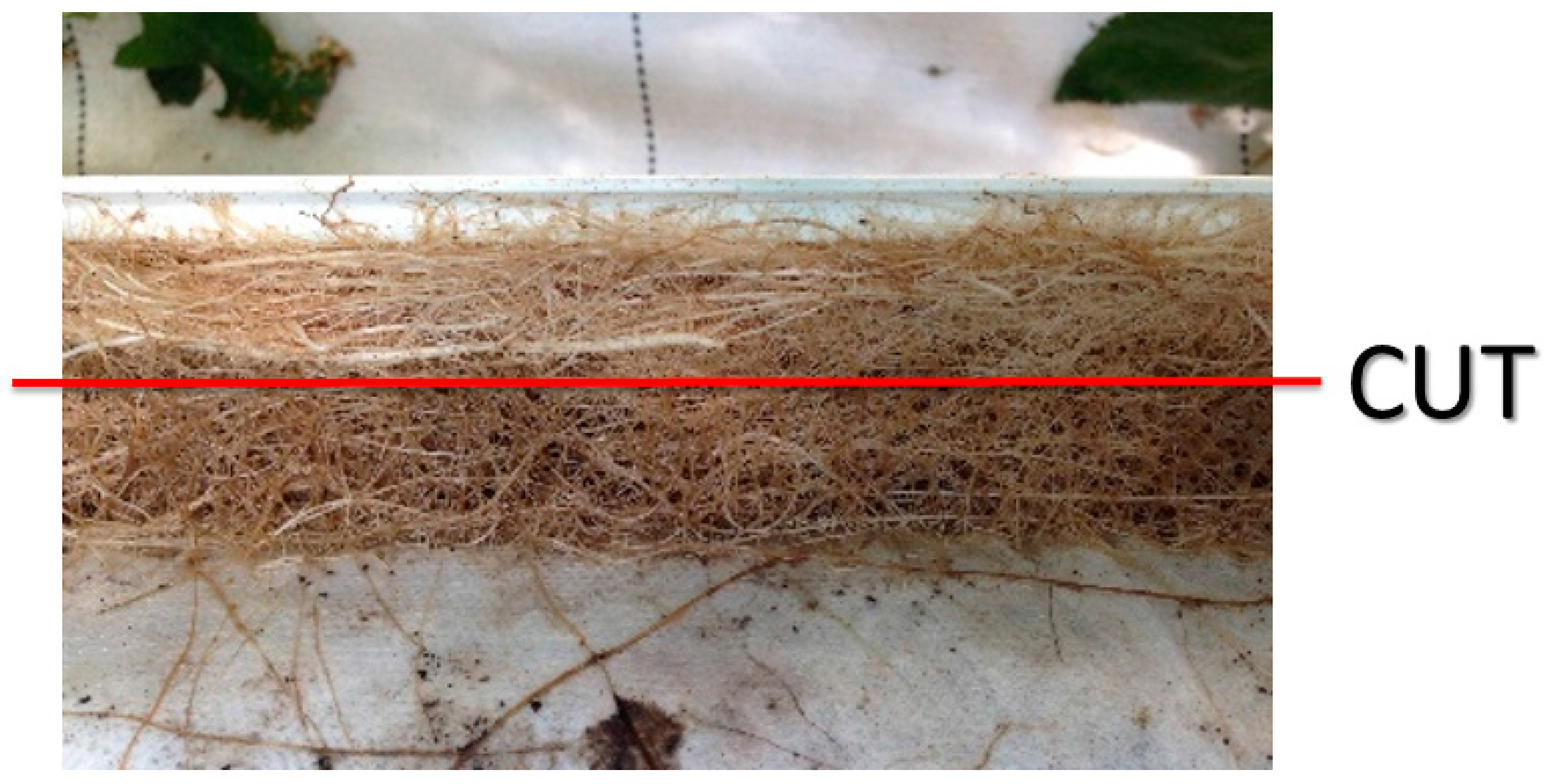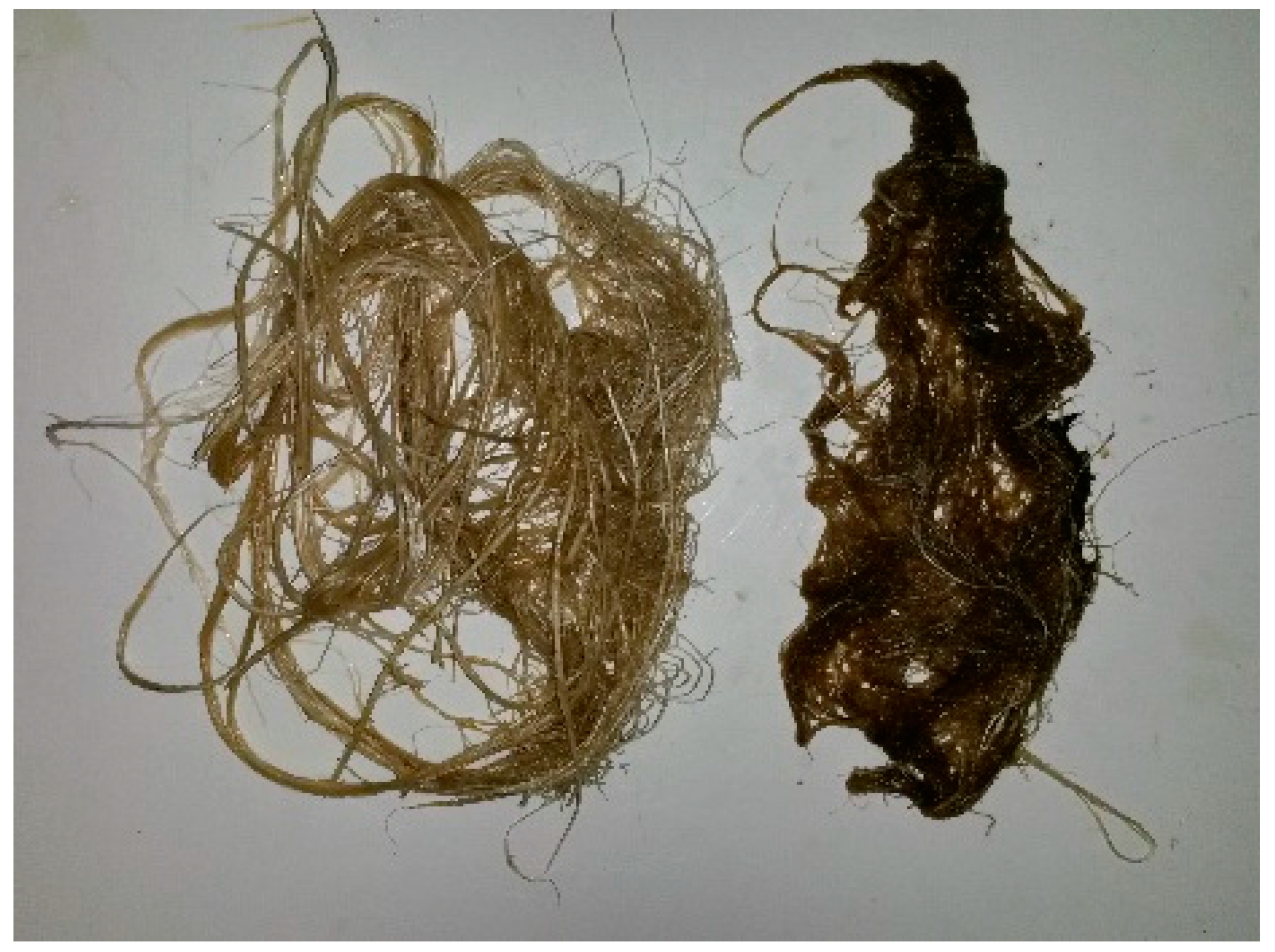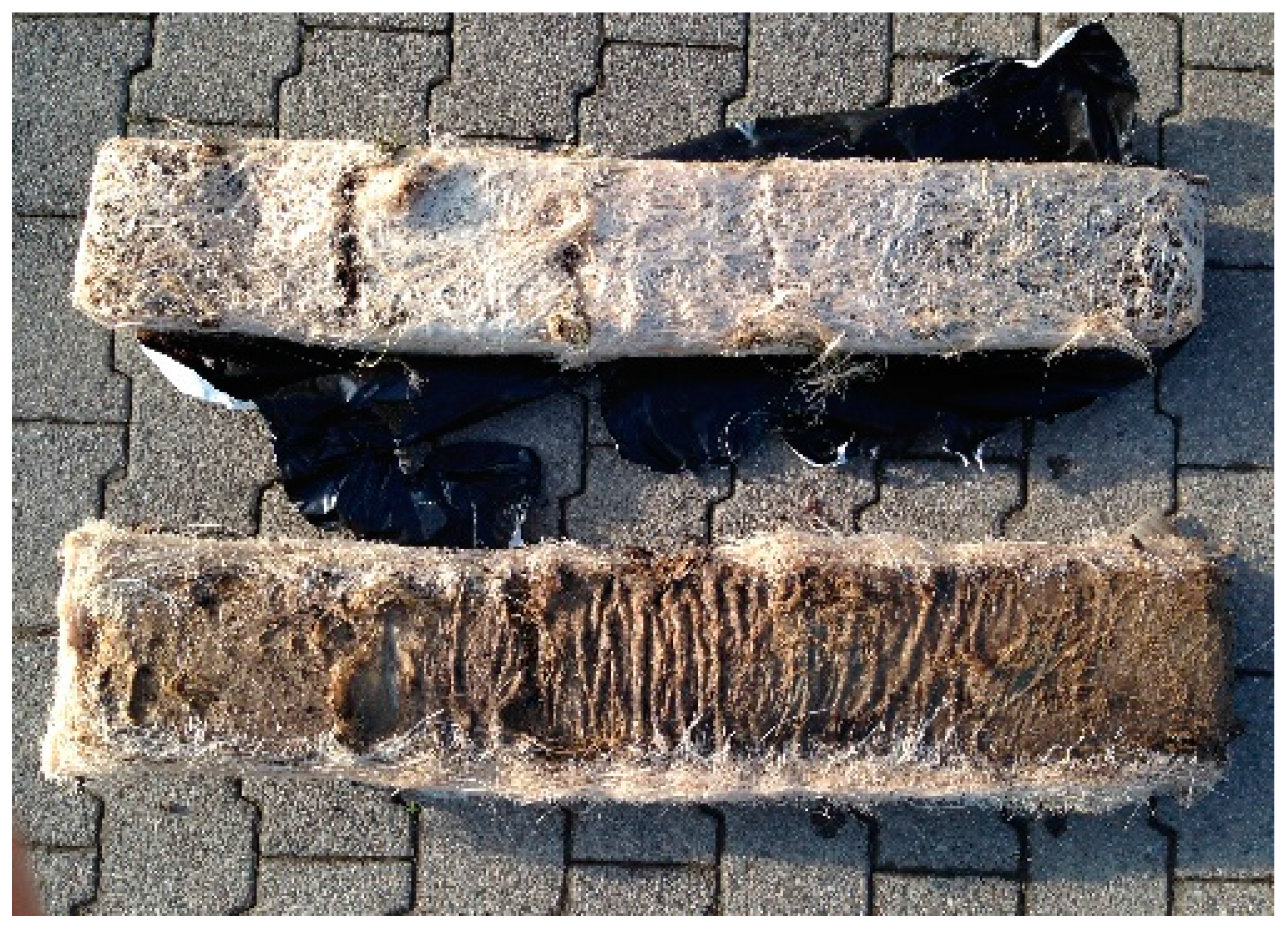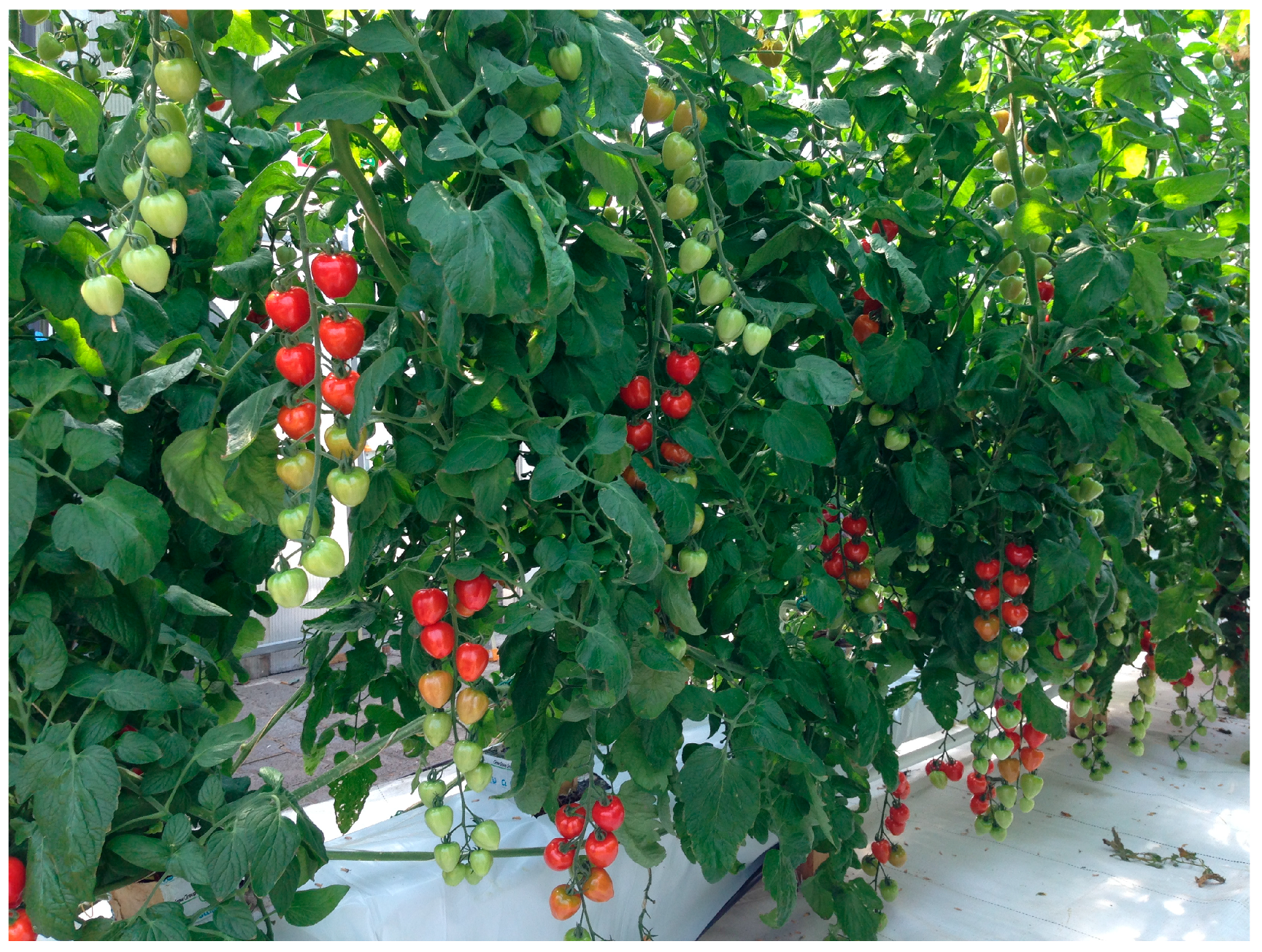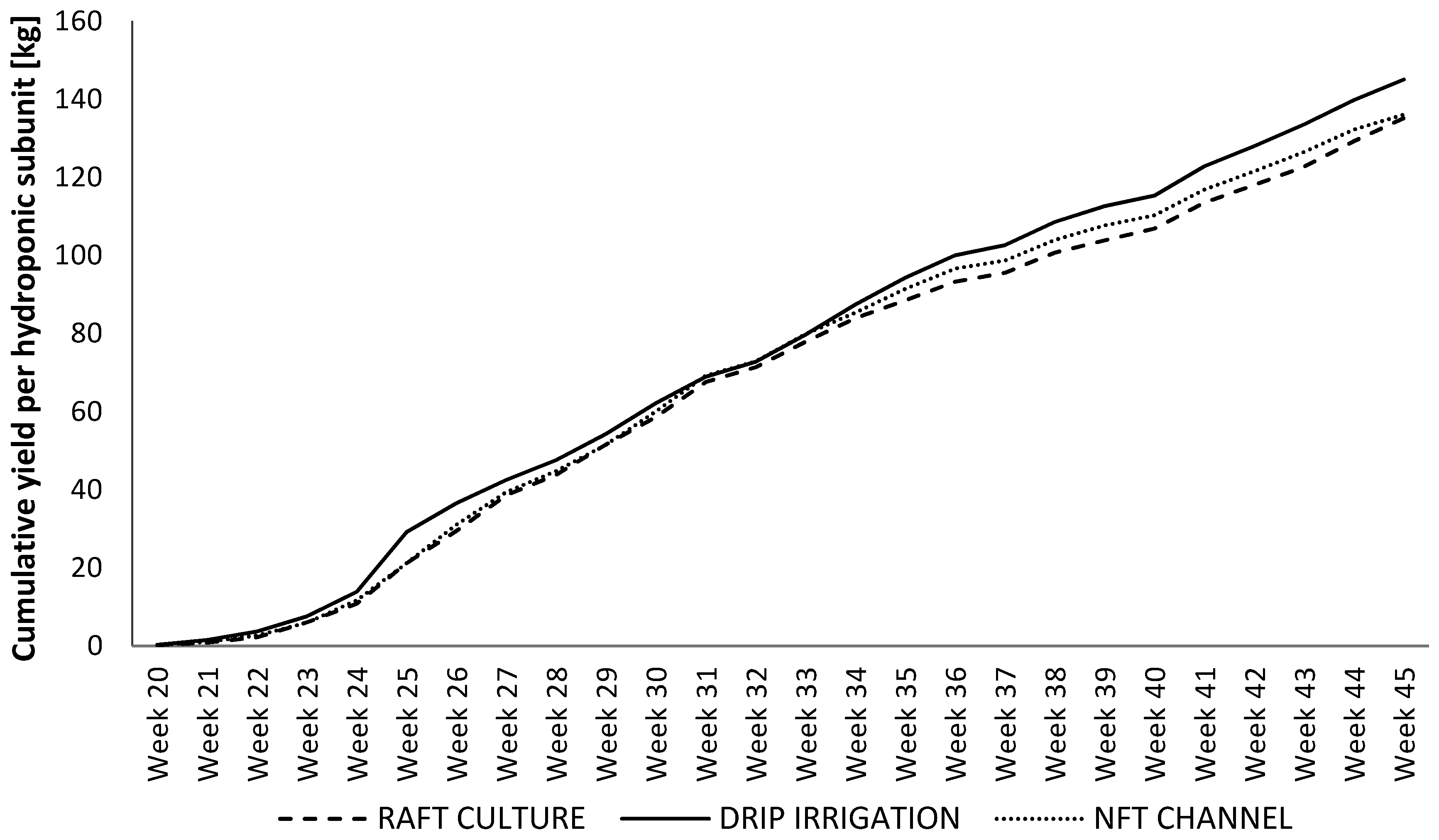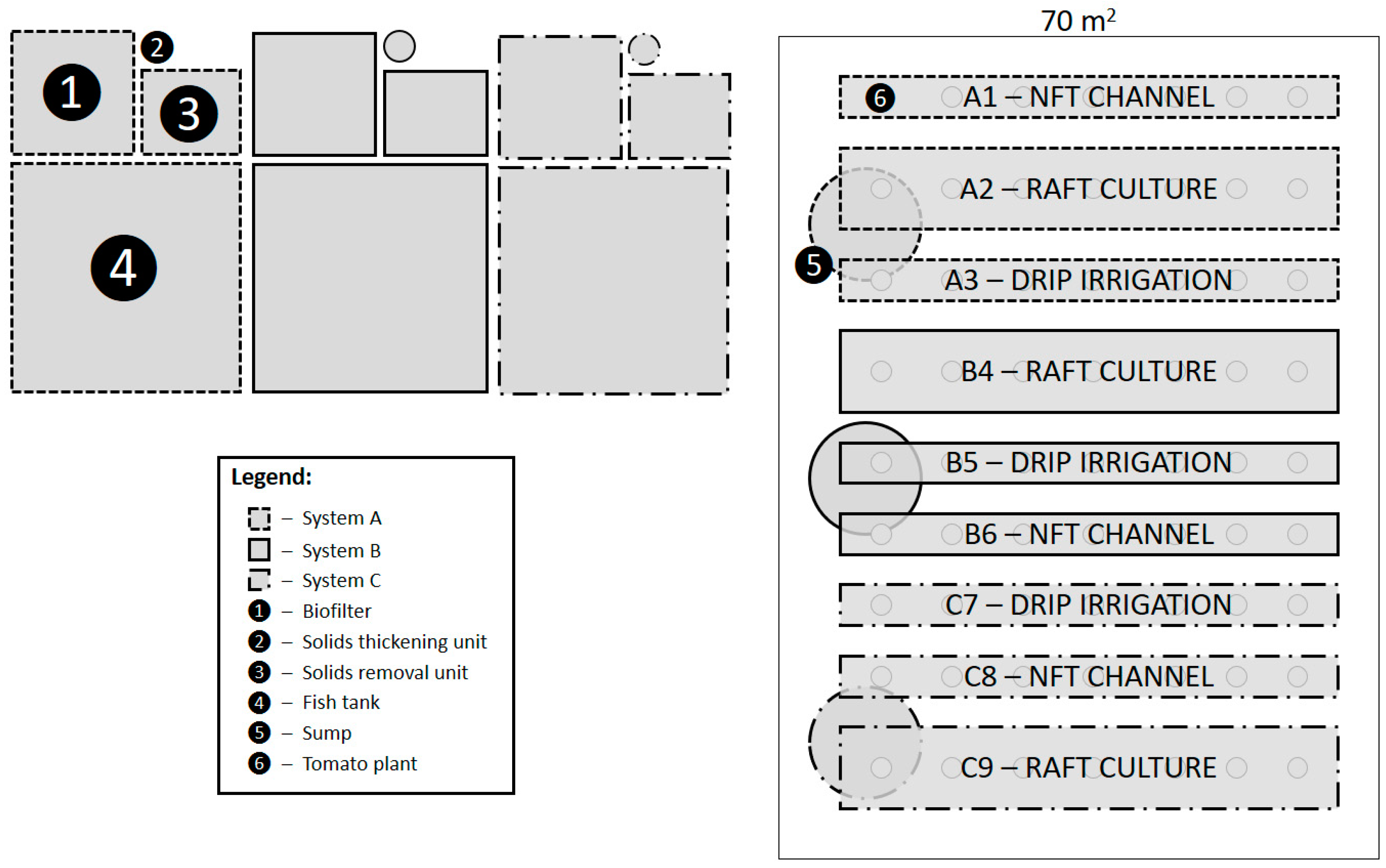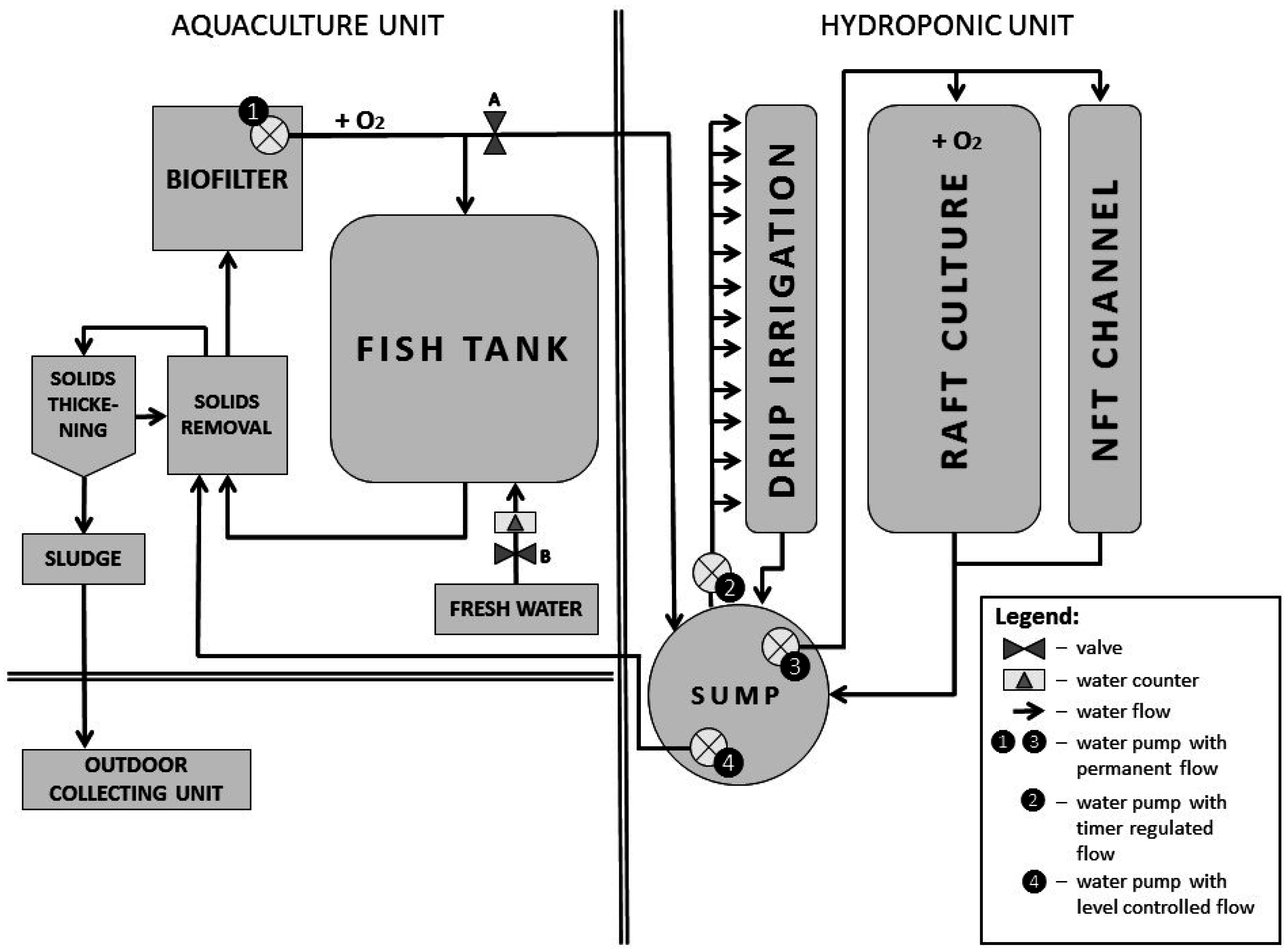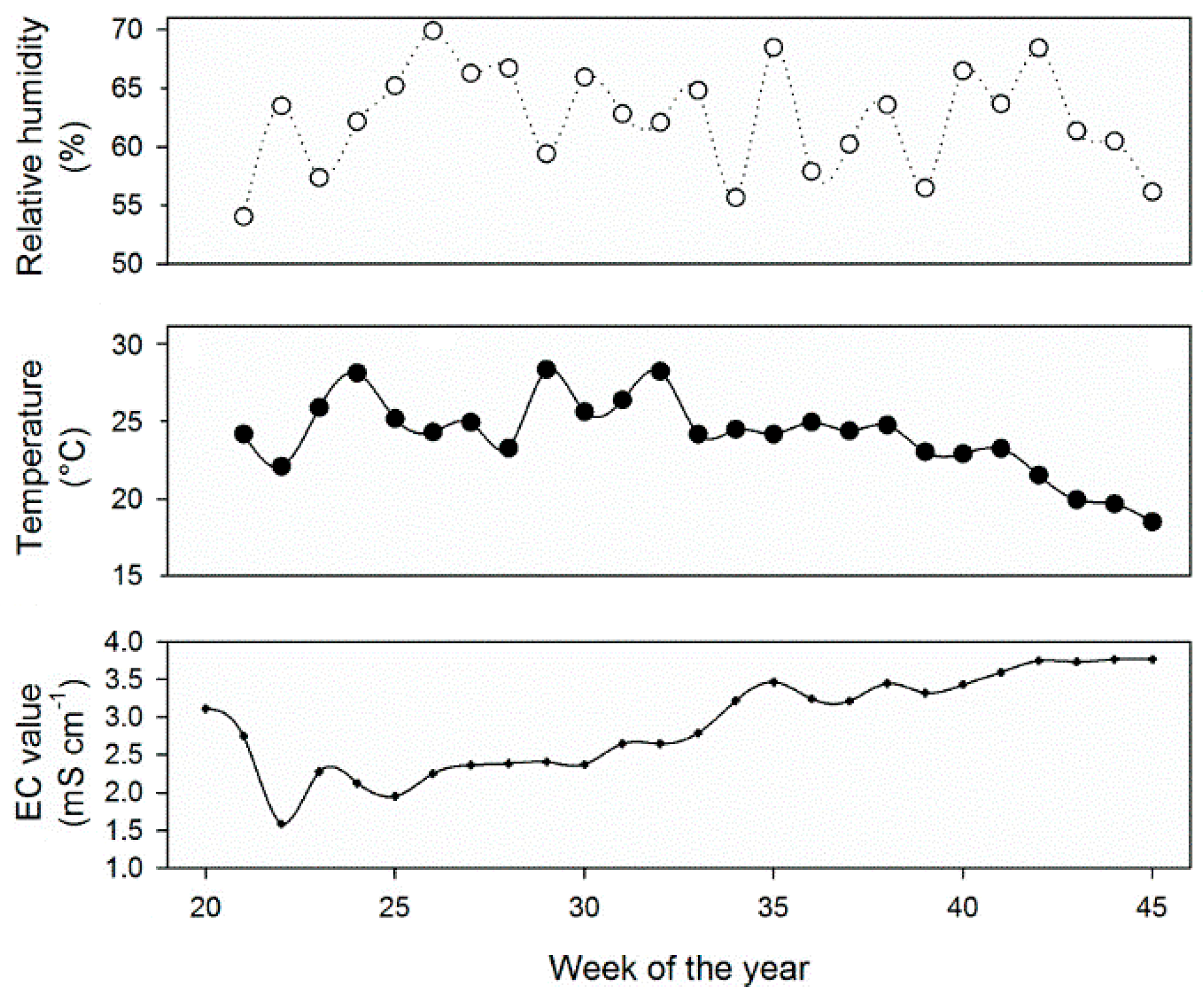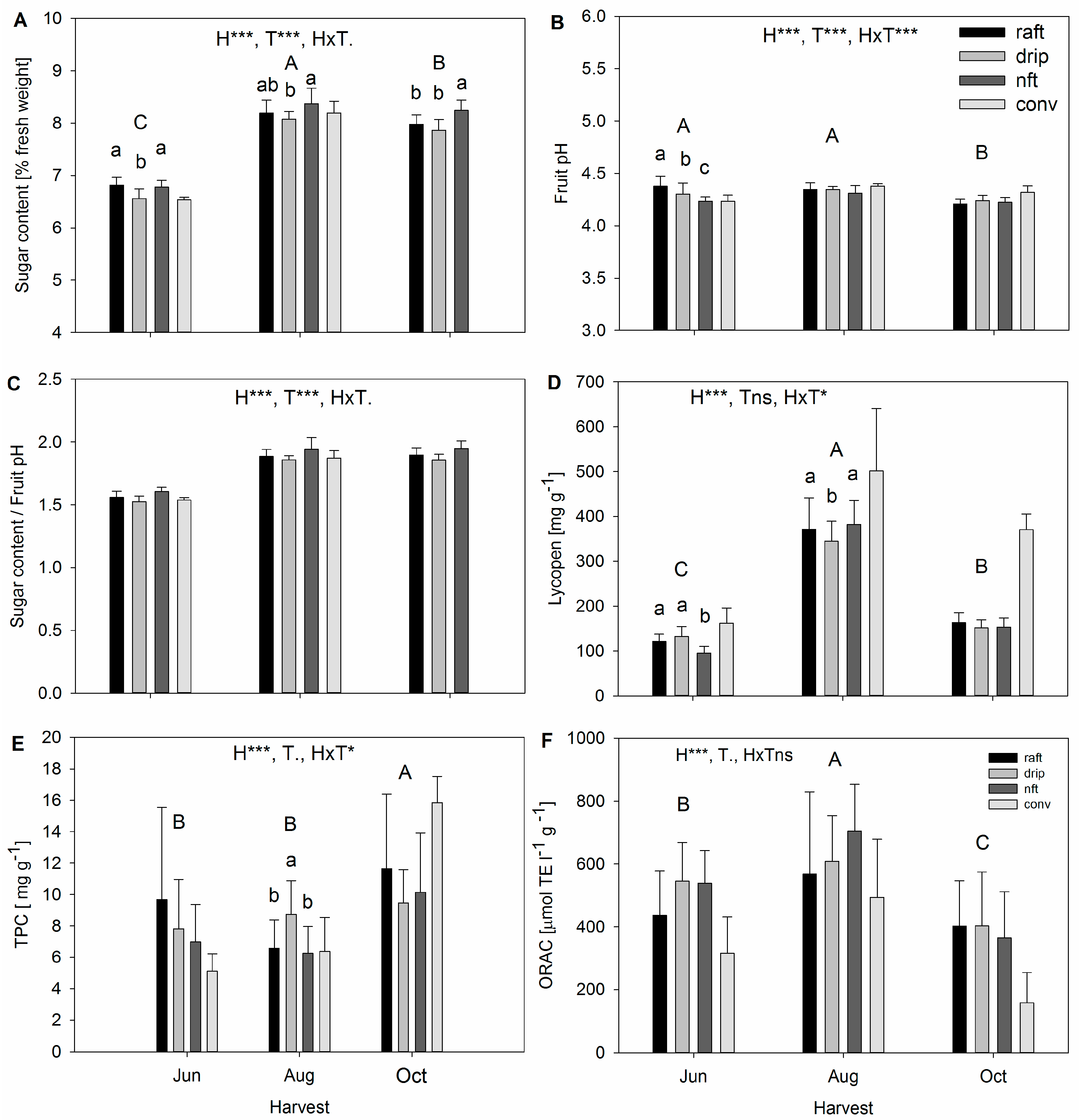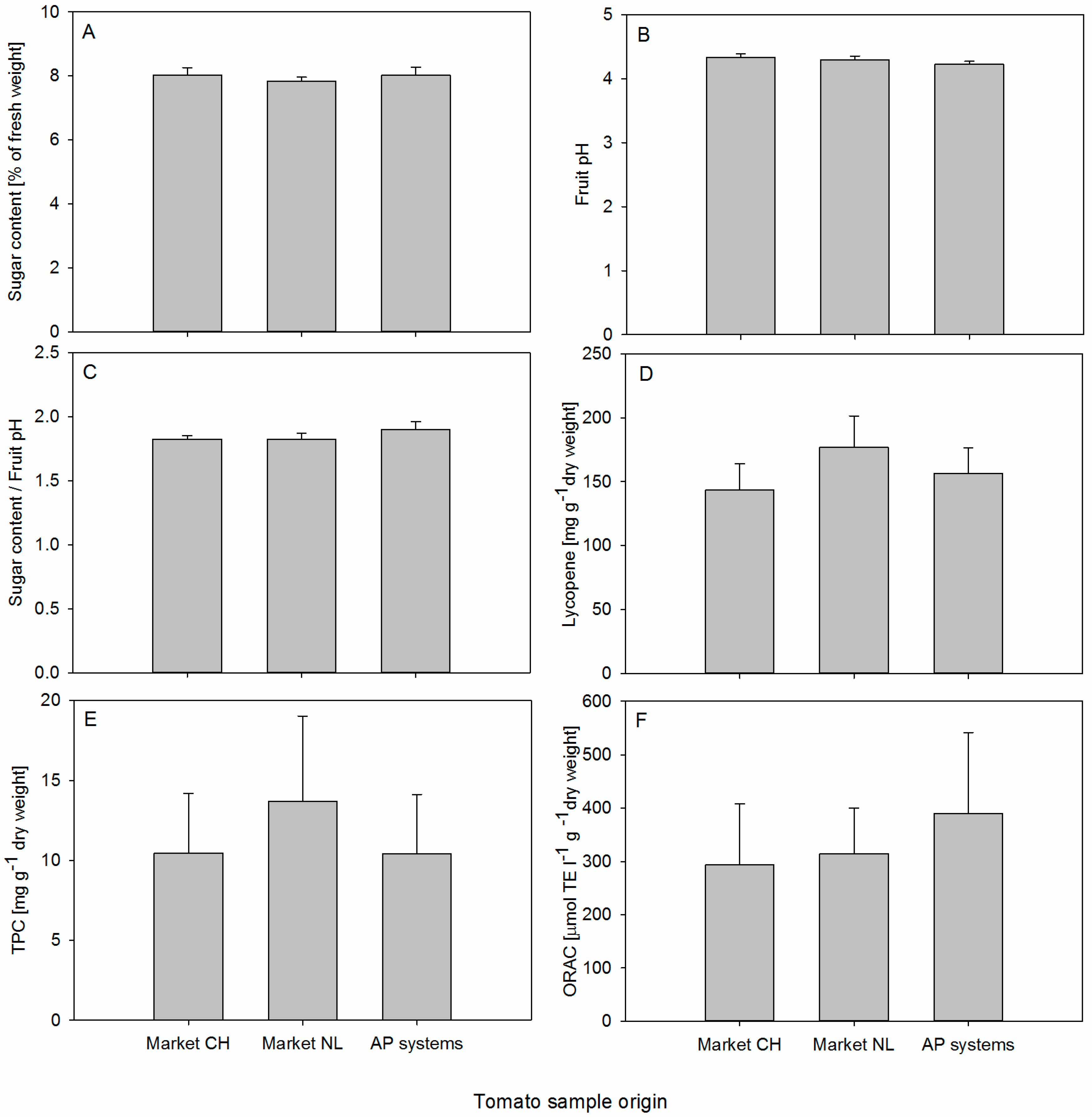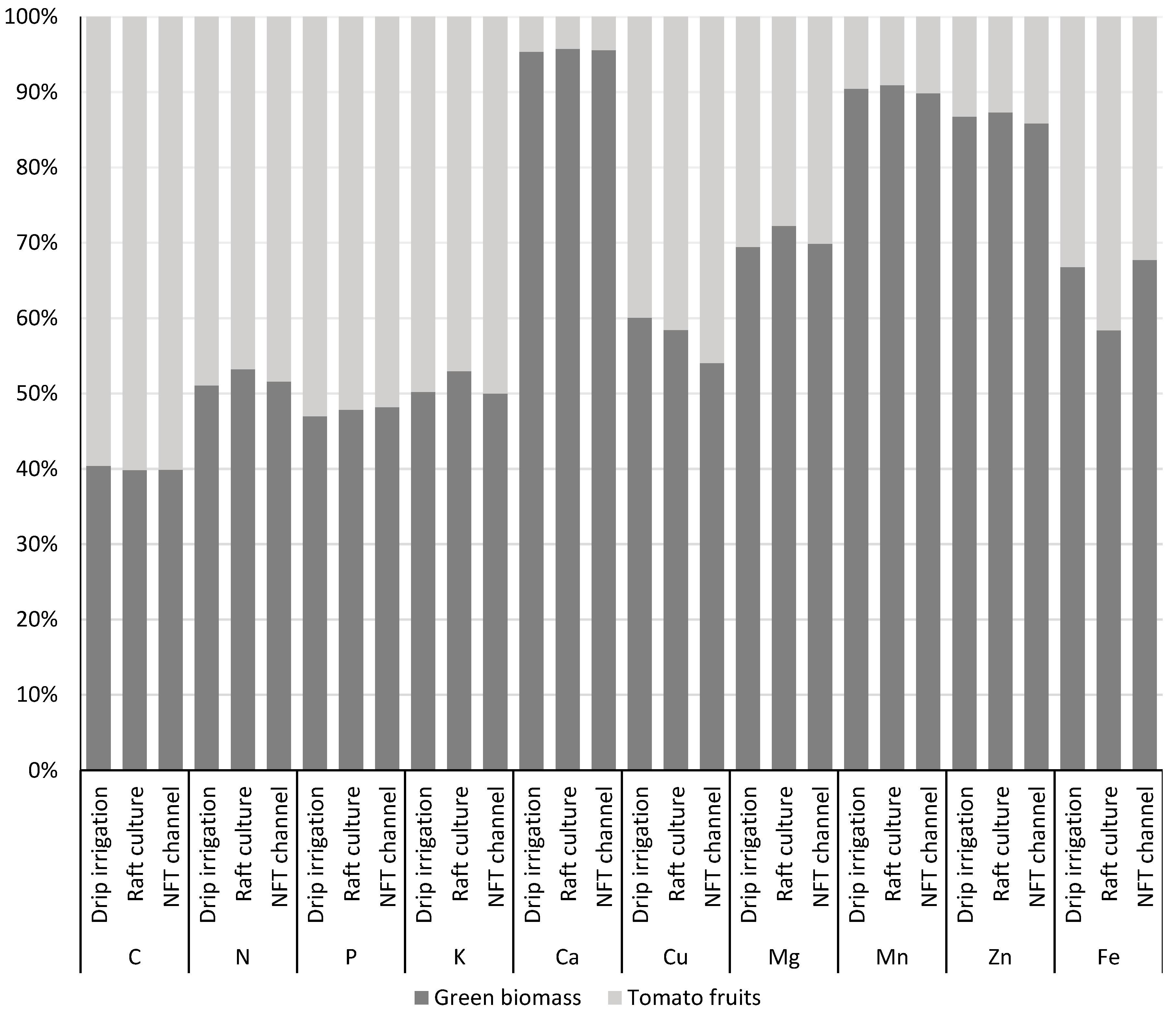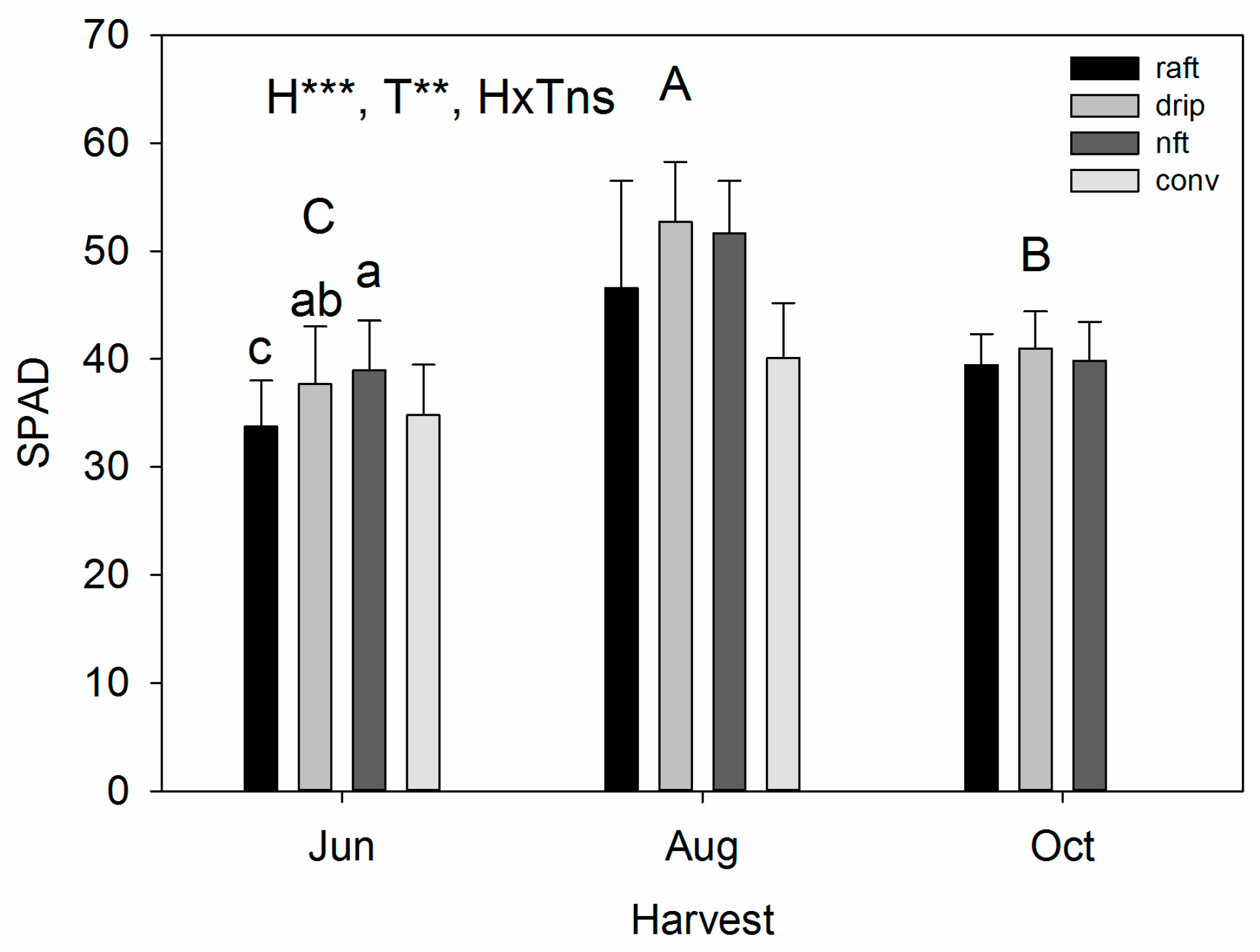1. Introduction
Due to the increasing demand for food and the need to save freshwater, food production efficiency must be increased. Currently, more than 70% of the world’s freshwater resources are used for agricultural purposes [
1], increasing the need for improved water use efficiency and the recycling of water in semi- or closed production systems. Food provision has a significant impact on the environment through greenhouse gas emissions, depletion of phosphorus, use of land and water resources, and release of chemical products [
2]. On the other hand, today more than 54% of the world’s population lives in urban areas. It is expected that the urbanization trend will increase to 66% of the global population by 2050 [
3].
Urban agriculture can produce food locally, uses resources very efficiently and has a minimum negative impact on the environment [
4]. Food producers not only face the challenge of supplying staple foods to meet caloric demand, but also the challenge of producing a wide variety of high quality foods with good nutritional properties. Therefore, it is important to find sustainable food production systems which can also be maintained within settlements or cities.
Aquaponics (AP) is one of the most promising sustainable systems for food production that combines hydroponic systems (HP) with recirculating aquaculture systems (RAS). It has the potential to play a major role in food provision and tackling global challenges such as water scarcity, food security, water pollution, high energy use and excessive food transport miles [
5]. If AP is operated in a closed water loop, it has little environmental impact because the food is produced with low water consumption [
6,
7]. Plant production yields in AP have been reported to be higher than for crops grown in soil [
8,
9], however data are scarce. In AP, nutrients enter the system in the form of fish feed. The feed is ingested and metabolized by the fish. The remains of the feed and the metabolic products from the fish dissolve in the water creating an aquaculture effluent that provides most of the nutrients required for plant growth in a HP part of the system. Microorganisms in the biofilter, on plant roots, and in the recirculating water release and convert the nutrients (e.g., phosphates from the debris, and ammonium to nitrate) and the plants assimilate them, thus treating the water, which flows back to the aquaculture component of the system [
5,
8]. In AP, fish, plants, and bacteria coexist in the same water, albeit in different compartments of the system [
10]. Different types of HP systems have been used for growing crops in AP: (i) drip irrigation; (ii) floating raft culture; (iii) gravel bed; and (iv) nutrient film technique (NFT) [
5,
6,
7,
8,
11,
12,
13,
14], however very few studies have compared different HP production systems in an AP context. The only paper we are aware of is by Lennard and Leonard [
15] compares floating rafts, gravel beds, and NFT for growing lettuce in AP and found that NFT produced significantly less biomass and removed the nutrients from fish water less efficiently than the other two systems.
Generally, all plant species that can be adapted to growth in HP systems can also be grown in AP [
16], meaning there is an extremely wide variety of choices. Savidov [
17] reported growing over 60 different types of plant species in AP. Lettuce, specialty greens and herbs (chives, basil, spinach, and watercress) have low to medium nutritional requirements and are well adapted to AP [
16]. Fruit yielding plants (tomato, bell pepper, cucumber, and squash) have a higher nutritional demand and perform better in heavily stocked AP systems. In indoor systems, the most commonly used tomatoes are greenhouse varieties which are better adapted than field cultivars to low light and high humidity conditions [
16]. According to FAOstat [
18], tomatoes are worldwide the second most important vegetable crop after potatoes. Tomatoes are rich in nutrients and vitamins which are associated with healthy food, i.e., carotenoids, flavonoids and lycopene [
19,
20]. Leaf nutrient concentrations can be used to detect the mineral nutritional status of the plants and thus might help to reveal differences in nutrient availability in different growing systems, whereas fruit nutrient content indicates the nutritional value for human consumption [
21]. Graber and Junge [
5] compared four varieties of tomatoes (Grapella, Rose of Berne, Frog King Golden Orb, and Sweet from Hungary) in AP, and in commercial HP cultivation with applications of mineral fertilizer according to Resh [
22]. They found that all varieties performed better in AP.
The purpose of this study was to compare tomato yields, morphological (external) and biochemical (internal) quality, and overall plant vitality in three different HP systems (NFT system, drip irrigation system, and floating raft culture). In addition, nutrient uptake and distribution within the tomato plants was also to be determined.
4. Discussion
For the first ten weeks (1 April–12 June 2014), the system was operated as a hydroponic system. This phase of the experiment was mainly for system calibration and to assure that all HP subunits had the same quality of plants at the start of the experiment. After connecting the hydroponic systems with the aquaculture nutrient, target values remained the same as before. The resulting difference for the plants after changing from a HP nutrient solution to the AP nutrition was the source of the nutrients (from mineral to mainly organic, provided through fish feed input) and water temperature. The AP plants received heated water (29 °C) due to the fish requirements and the HP water was provided at ambient greenhouse temperatures which were usually lower than those of the aquaculture.
Data of average yields of this particular tomato variety are not available. However, this variety could be compared with other cherry tomato varieties. Lattauschke [
33] and Testa et al. [
34] reported average yields of 15.0 and 16.6 kg·m
−2, respectively. The exact durations of the seasons were not declared. The cumulative yield in our study was higher, ranging between 16.8 and 18.3 kg·m
−2, depending on the HP system. Lennard and Leonard [
15] compared lettuce growth in floating rafts, gravel beds, and NFT in AP. They found that NFT produced significantly less biomass and removed the nutrients from fish water less efficiently than the other two. In this study, also both, cumulative yield and cumulative number of fruits were lowest in the NFT system, and highest in the drip irrigation system. This system was the only HP system with a pulsing water flow, which provided more air and thus oxygen to the roots, which is known to positively affect plant growth and yield [
35]. Problems with the floating raft culture (clogging of the aeration pipes) and the NFT system (root biomass blocking the water flow in the channels) during the season must be mentioned. This increased the maintenance work needed to keep the system in optimal condition, but could also have affected the plants. This was most obvious in the raft culture system where the aeration pipes clogged and the water mixing in the basin was hindered, especially in the corners, forcing the plants to continuously develop new roots. The drip irrigation system, which is the most commonly used cultivation method in commercial systems, on the other hand, demands a higher electricity input because of the more powerful pumps required, but nevertheless it was the cultivation system with the lowest maintenance input.
The fruit quality in the investigated systems was generally high, reflected by the low proportion of either wrong sized fruits (category 2) or misshapen or damaged fruits (category 3), which were always below 2.5% and 9%, respectively. A higher fraction of non-marketable fruits (higher weight and number) was observed in the raft culture system. This could be related to more cracked fruits harvested at the ripe stage which may have resulted from the unlimited supply of water which has frequently been reported to promote fruit cracking in tomatoes [
21,
36].
Fruit internal quality is defined by parameters such as the content of fat, lipids, proteins, vitamins, mineral nutrients and pigments [
20], as well as health related parameters such as TPC and ORAC [
37]. In this study, the sugar content of the investigated fruits was generally high and, as to be expected, the time of harvest had the greatest effect on fruit sugar content. The lowest sugar contents were found when the plants were young, and there was not as much available light (duration and intensity) as in the summer. Although significant, the differences between the HP subunits were small, at less than 0.5%. It is unlikely that this difference can be perceived by consumers, and thus it cannot be truly stated as an advantage or disadvantage for the given HP system. Nevertheless, it seems that the lower fruit sugar content in the drip irrigation system is related to the higher fruit biomass produced (significant only for cumulated yield and fruit number) and thus might be a dilution effect. There were no pronounced differences in fruit pH or sugar-to-fruit pH ratio, indicating that they were very little affected by the HP systems and thus most likely have a negligible effect on internal fruit quality. The observed lycopene concentrations were generally at the upper limit of the reported range of 20 to 400 μg·g
−1 [
20]. The differences between the HP systems were not consistent in the three harvests, indicating marginal effects of season on the lycopene content of the fruits. The same was true for TPC and ORAC content. The observed TPCs were in the middle of the range of 1.2 to 22 μg·g
−1 fresh weight that has been reported for processed tomatoes [
38]. The observed ORAC values were in the upper range of 12–323 μmol·TE·g
−1 dry weight reported by Li et al. [
37] for processed tomatoes and higher than reported in Zhou and Liangli [
39].
Fruit mineral contents of P, K, Ca, Mg were found to be in similar range to those reported for tomatoes in general, with Fe and Zn values higher in our study [
20]. However, Dobromilska et al. [
40] reported similar ranges for N, P, K, Ca, Mg, Fe and Zn in cherry tomato as those found in this study. This indicated that the tomatoes produced in our experiment have the expected mineral nutrient content for market cherry tomatoes. When comparing the HP systems, the only noteworthy difference was found for C and Mn. The lower C concentration in the raft culture is likely to be the result of higher water availability. The higher Mn concentrations found in the raft culture can probably be explained by the altered oxidative conditions in the standing water body rendering Mn to better plant available ions.
In general, the fruit quality parameters of the AP and commercially produced fruits were in the same range. Only in terms of lycopene did the commercial fruits tend to have higher contents, where lower ORAC contents were also observed. Whether this observation can be attributed to slightly different ripening stages (commercial fruits were harvested slightly later), fungal fruit infection at the third harvest of the commercially produced fruits, or to the slightly different mineral nutrition (discussed below) is not clear. The higher ORAC observed in the HP systems might indicate that AP production seems to be less stressful for the plants and thus seems to favor the production of high-quality tomatoes.
Even though literature [
31] indicates that there might be interference between high sugar content and TPC measurements, our extracts were diluted by a high factor so that the sugar showed no effect on the TPC measurement. Therefore, a correction factor was not necessary. The comparison to values obtained from the supermarket tomatoes proved that tomato fruits from the AP systems reach the same or slightly better quality than tomatoes sold in stores.
The higher SPAD values that correspond to the higher leaf chlorophyll contents observed in August and partly in October can be related to the N status as reflected by the leaf analysis which showed significantly lower leaf N concentration in June. This conclusion is supported by observations reported from Ulissi et al., and Fontes and de Araujo [
41,
42]. Fontes and de Araujo [
42] reported a critical value of 37 mg·g
−1: the values found in the June harvest and the others were close by. However, higher irradiation, as observed in August might also have affected leaf chlorophyll contents [
43]. Leaf stomatal conductance and temperature were mostly linked to prevailing environmental conditions reflected by time of harvest in our experiment. The growing systems did not affect either parameter. Despite the fact that commercially grown plants were measured on a different day at similar time, the weather condition values were in the same range.
The leaf mineral analysis revealed that mineral nutrition of the AP plants was suboptimal at the beginning of the experiment and the first sampling harvest, when values below the sufficiency range reported by Adams [
35] were found for P, K, S, Ca, Mg, Fe, Cu, and Zn. This suboptimal mineral nutrition was very likely caused by the lower productivity (fruit yield), plant vitality (SPAD) and fruit quality (sugar content) observed in the first harvest. Optimizing the nutrient availability during this initial harvesting phase would very likely increase the overall output and quality of tomato fruit from the AP systems. However, providing nutrients in the solution is not enough, it is also important to be aware of the root health status ensuring plants can absorb nutrients efficiently. Deficient leaf mineral concentrations of P were found in the three sampling harvests and were more pronounced in the first harvest. However, in the second and the third sampling harvests, the values of 3.6 and 3.3 mg·g
−1, were only slightly below the reported sufficiency range of 4.0 to 6.5 mg·g
−1 [
35]. The fact that no yield reduction was observed compared to commercial production, where leaf P concentrations of 5.0 mg·g
−1 were found (
Table A3), indicated that lower leaf P concentrations can be sufficient for high yield cherry tomato production. In contrast, we found very high values for Mn, which even increased to toxic levels above 1000 μg·g
−1 [
35] during the season. Although, we did not observe negative effects on yield, the higher TPC contents in fruits might be a result of the higher Mn. To avoid negative effects, Mn availability should be better controlled in future studies.


